人教版(2019)选修二Unit 3 Food and Culture Reading and Thinking 课件(共25张PPT 内嵌音频)
文档属性
| 名称 | 人教版(2019)选修二Unit 3 Food and Culture Reading and Thinking 课件(共25张PPT 内嵌音频) | 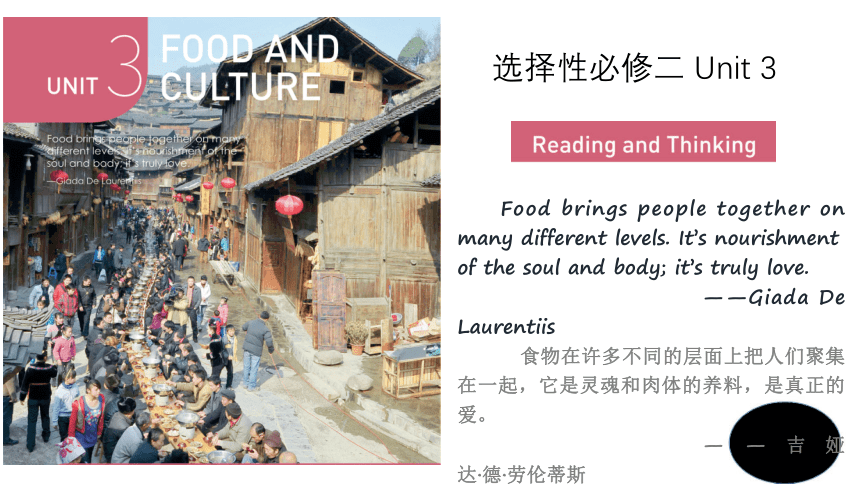 | |
| 格式 | pptx | ||
| 文件大小 | 30.1MB | ||
| 资源类型 | 教案 | ||
| 版本资源 | 人教版(2019) | ||
| 科目 | 英语 | ||
| 更新时间 | 2023-10-25 21:48:00 | ||
图片预览

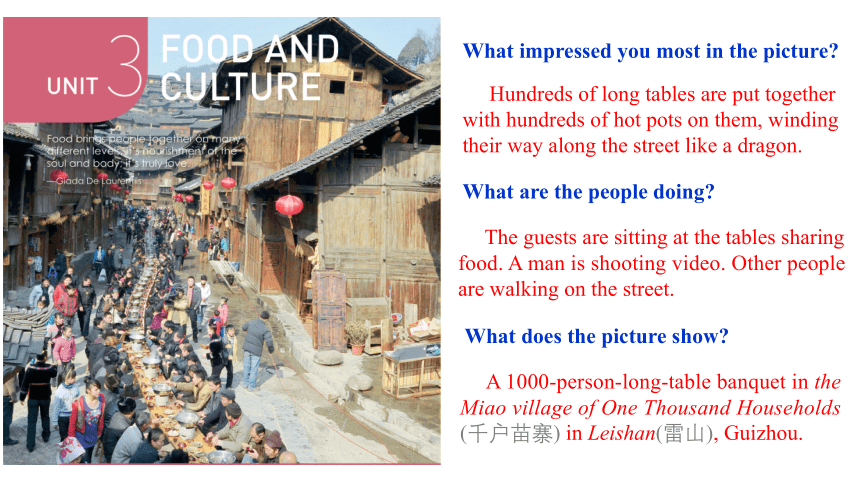

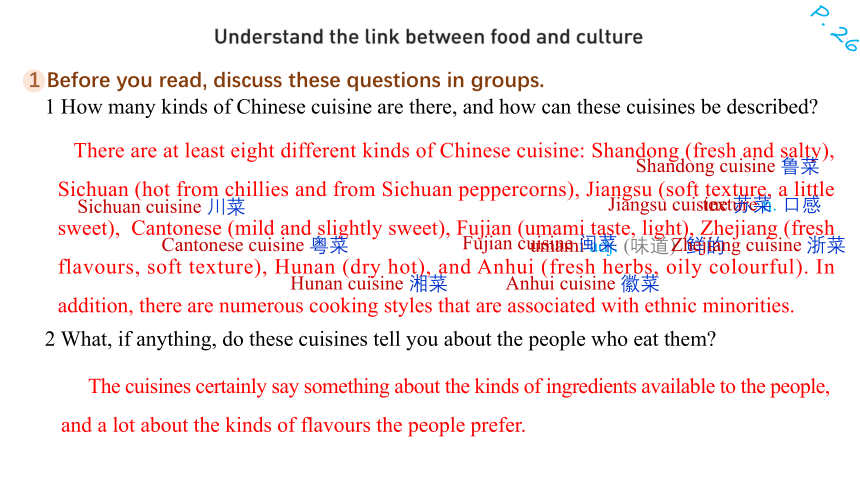
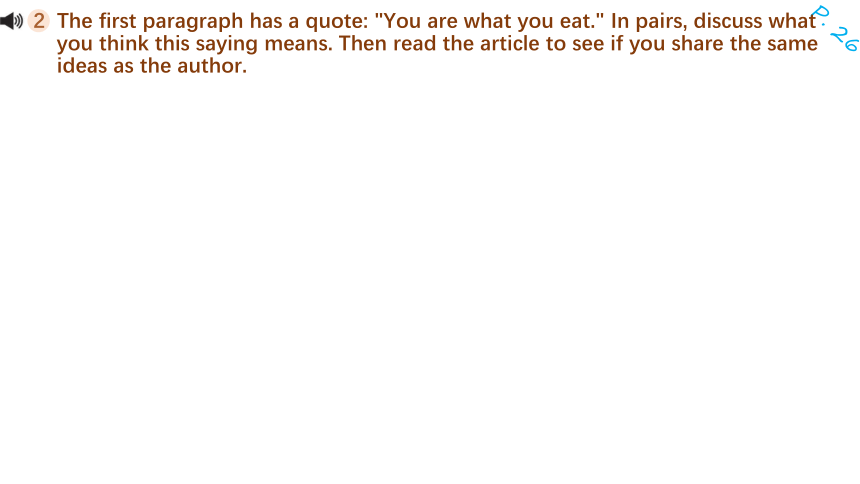
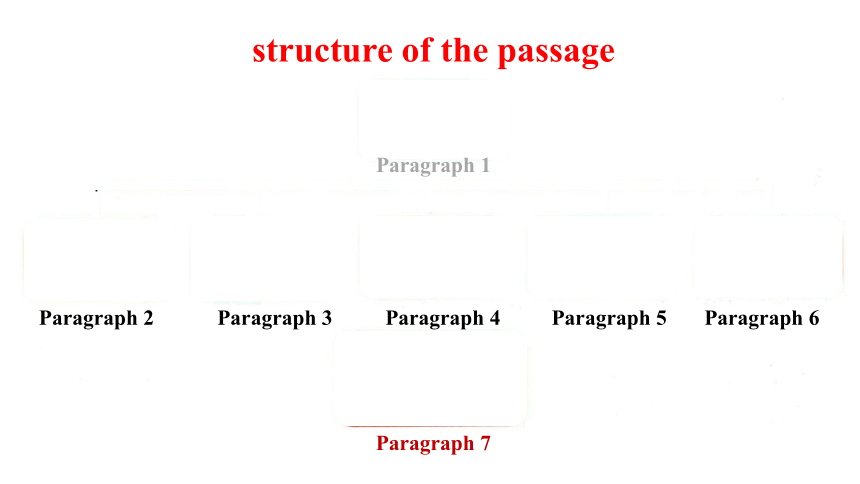
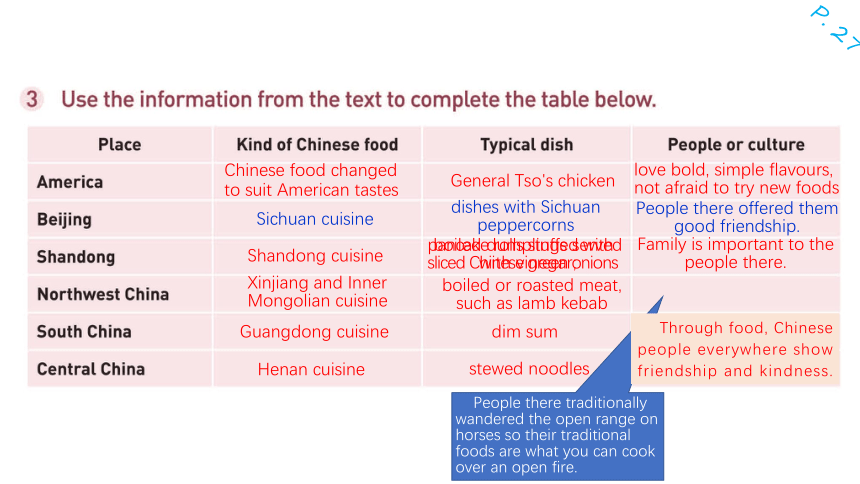
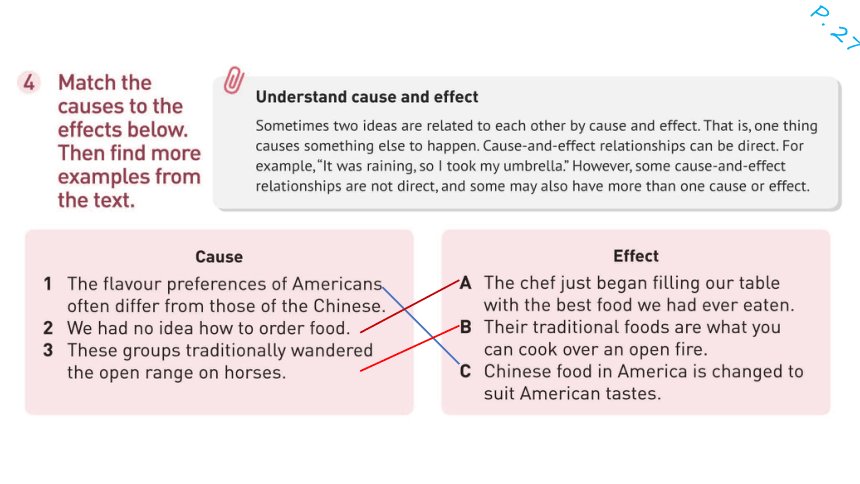
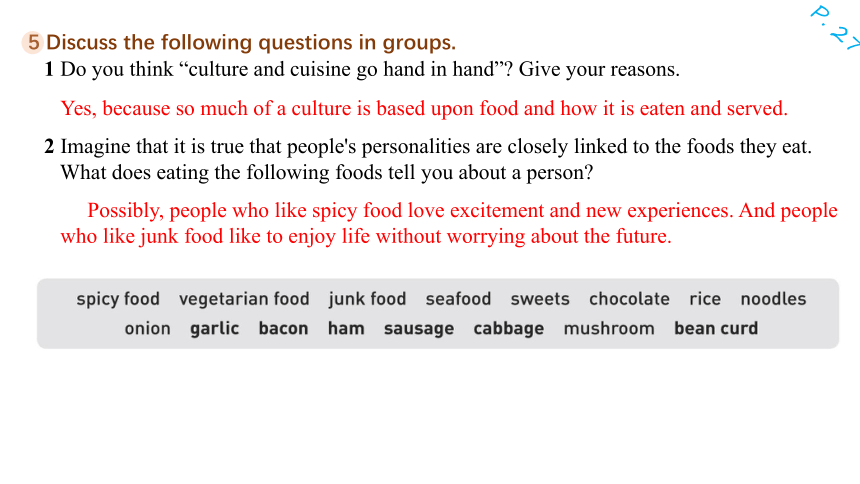
文档简介
(共25张PPT)
选择性必修二 Unit 3
Food brings people together on many different levels. It’s nourishment of the soul and body; it’s truly love.
——Giada De Laurentiis
食物在许多不同的层面上把人们聚集在一起,它是灵魂和肉体的养料,是真正的爱。
——吉娅达·德·劳伦蒂斯
The guests are sitting at the tables sharing
food. A man is shooting video. Other people
are walking on the street.
What impressed you most in the picture
Hundreds of long tables are put together
with hundreds of hot pots on them, winding
their way along the street like a dragon.
What are the people doing
A 1000-person-long-table banquet in the
Miao village of One Thousand Households
(千户苗寨) in Leishan(雷山), Guizhou.
What does the picture show
Eight Cuisines in China
1 Before you read, discuss these questions in groups.
1 How many kinds of Chinese cuisine are there, and how can these cuisines be described
2 What, if anything, do these cuisines tell you about the people who eat them
P. 26
There are at least eight different kinds of Chinese cuisine: Shandong (fresh and salty),
Sichuan (hot from chillies and from Sichuan peppercorns), Jiangsu (soft texture, a little
sweet), Cantonese (mild and slightly sweet), Fujian (umami taste, light), Zhejiang (fresh
flavours, soft texture), Hunan (dry hot), and Anhui (fresh herbs, oily colourful). In
addition, there are numerous cooking styles that are associated with ethnic minorities.
The cuisines certainly say something about the kinds of ingredients available to the people,
and a lot about the kinds of flavours the people prefer.
texture n. 口感
umami adj. (味道) 鲜的
Shandong cuisine 鲁菜
Sichuan cuisine 川菜
Jiangsu cuisine 苏菜
Cantonese cuisine 粤菜
Fujian cuisine 闽菜
Zhejiang cuisine 浙菜
Hunan cuisine 湘菜
Anhui cuisine 徽菜
P. 26
2 The first paragraph has a quote: "You are what you eat." In pairs, discuss what
you think this saying means. Then read the article to see if you share the same
ideas as the author.
structure of the passage
Paragraph 1
Paragraph 2
Paragraph 3
Paragraph 4
Paragraph 5
Paragraph 6
Paragraph 7
P. 27
Chinese food changed to suit American tastes
General Tso's chicken
love bold, simple flavours, not afraid to try new foods
People there offered them
good friendship.
Sichuan cuisine
dishes with Sichuan
peppercorns
Shandong cuisine
boiled dumplings served with vinegar;
pancake rolls stuffed with sliced Chinese green onions
Family is important to the
people there.
Xinjiang and Inner
Mongolian cuisine
boiled or roasted meat,
such as lamb kebab
People there traditionally
wandered the open range on
horses so their traditional
foods are what you can cook
over an open fire.
Guangdong cuisine
dim sum
Henan cuisine
stewed noodles
Through food, Chinese
people everywhere show
friendship and kindness.
P. 27
P. 27
5 Discuss the following questions in groups.
1 Do you think “culture and cuisine go hand in hand” Give your reasons.
2 Imagine that it is true that people's personalities are closely linked to the foods they eat.
What does eating the following foods tell you about a person
Yes, because so much of a culture is based upon food and how it is eaten and served.
Possibly, people who like spicy food love excitement and new experiences. And people
who like junk food like to enjoy life without worrying about the future.
Language study
P. 26
2 The first paragraph has a quote: "You are what you eat." In pairs, discuss what
you think this saying means. Then read the article to see if you share the same
ideas as the author.
put sth. + 状语 ……地说 (to put it simply简单地说 to put it mildly 说得轻点或婉转点)
e. g. It’s fairly risky. Or to put it another way, don’t try this at home.
To put it simply(=Put simply / Simply put), he’s a fool, and he never deserved you.
Simply put, a case in point is a specific example to support a statement.
_____________
P. 26
2 The first paragraph has a quote: "You are what you eat." In pairs, discuss what
you think this saying means. Then read the article to see if you share the same
ideas as the author.
refer to 提到、谈到;查阅、参考;指的是
e. g. I promise not to refer to the matter again. (提及)
Don’t refer to a dictionary every time you come across a new word.
I knew who he was referring to though he didn’t mention the name.
_________
P. 26
2 The first paragraph has a quote: "You are what you eat." In pairs, discuss what
you think this saying means. Then read the article to see if you share the same
ideas as the author.
a case in point 恰当的例子; 很好的例子
e. g. Our sales have increased by 20%, and a case in point is the surge(猛增) in online orders.
The success of our new product launch serves as a case in point.
As for the negative effect of climate change, the melting polar ice is a case in point.
___________
P. 26
2 The first paragraph has a quote: "You are what you eat." In pairs, discuss what
you think this saying means. Then read the article to see if you share the same
ideas as the author.
consist of … 由……组成、构成 consist in … 在于……;取决于……
e. g. The buffet consists of 4 to 6 different dishes.
The audience of cartoons consists mainly of young kids.
Happiness does not consist in how much property you have.
________
For example, America’s most popular Chinese dish is General Tso’s chicken,
which consists of fried chicken covered in a sweet sauce, favoured with hot red peppers.
例如,在美国最受欢迎的中国菜是“左宗棠鸡”,它是裹着甜酱的炸鸡,佐以
红辣椒。
过去分词短语作后置定语①
过去分词短语作后置定语②
flavour U & C (饮料、食物的)口味 vt. 给(饮料、食物的)调味
e. g. This dish is stronger in flavour than the other dishes.
The wine has a delicate fruit flavour.
Glutamate(味精) is used to flavour many dishes. (调味)
_______
____________________________________________________________________________________
____________________________________________________________________________________
________
注意:flavour表示某种饮食给人的整体感官体验,包括味觉、香气、口感甚至温度;
taste仅表示舌头感知到的甜、酸、咸、苦和鲜等味道。
P. 26
2 The first paragraph has a quote: "You are what you eat." In pairs, discuss what
you think this saying means. Then read the article to see if you share the same
ideas as the author.
recipe C (某道菜的)做法、食谱 cuisine U (某国或某地区的)烹调风格
e. g. Here’s a recipe for tomato soup.
Do you know any recipe for chicken soup
The cuisine of Japan is low in fat.
The cuisine of coastal countries features seafood. (滨海国家的菜以海鲜为特色。)
_____
dish C (根据某一菜谱做好装盘的一道)菜
P. 26
authentic adj. (以最初的或传统的方式做的)正宗的→原作的、真迹的→真实的;逼真的
e. g. He likes to eat authentic Wuhan hot dry noodles. (正宗的)
Authentic Italian dishes are very healthy. (正宗的)
The painting is worth a fortune if it is authentic. (真迹)
You have to provide authentic information about yourself in your application. (真实)
_______
P. 26
Tired, hungry, and not knowing a word of Chinese, we had no idea how to order,
so the chef just began filling our table with the best food we had ever eaten.
______________________________________________
___________________________________________________________________________________________________________________
___________
并 列 分 句 ①
并 列 分 句 ②
并列连词
形容词和分词短语并列做主句的原因状语
分句②的定语从句
__________________________
形容词短语作状语:修饰谓语的同时说明主语的状态,说明谓语发生的原因、伴随情况等等。
e. g. Curious, they looked into the cave. (原因)
Jane rose at the break of day, hungry and thirsty. (伴随)
To the mother’s relief, the little boy came home, safe and sound. (伴随)
Seeing the car on fire, we could do nothing, helpless. (伴随)
P. 26
boiled dumplings served with vinegar 水饺配醋
served with (某道菜或饮料)与(某配料、调料或食物)搭配(吃或喝)
e. g. This dish is served with chicken and rice.
Coffee is usually served with cookies.
His breakfast is often steamed buns served with vinegar (小笼包).
________________________________
P. 26
“with + 宾语 + 宾补” 在此句中作定语,修饰affair
e. g. The old man with his daughter supporting him is a famous scientist.(with+宾语+doing)
The boy with his head hung low failed in the exam. (with + 宾语 + 过去分词)
Do you know the girl with a red skirt on (with + 宾语 + 方位副词)
___________
______________
P. 26
wander the open range on horses 骑马漂泊在开阔的牧区
wander vi. & vt. (在某地)闲逛、漫步、徘徊;流浪、漂泊
e. g. The Jews had wandered for decades before entering the promised land(应许之地).
Dusk witnessed many homeless people wandering the streets.
_____________________________
P. 27
sb.’s travels (某人去多地的长途)旅游、旅行
e. g. He’s learned a lot about the varied cultures on his travels abroad.
They came across some interesting people on their travels in Thailand.
_________
P. 27
serving C (饮食中供一人吃喝的)一份
e. g. This should make enough for four servings.
I wonder how many servings of soup you have prepared for us.
_______
P. 27
exceptional adj. 非常好的、杰出的;不寻常的、非凡的
e. g. Those who have been admitted to Beijing University are exceptional students.
People with exceptional abilities will make exceptional achievements.
__________
P. 27
consume vt. 吃、喝;消耗
e. g. He had consumed a large quantity of alcohol before he died. (喝)
The electricity industry consumes large amounts of fossil fuels. (消耗)
_______
P. 27
go hand in hand (同时发生或同时存在)齐头并进;相辅相承;如影随形;密不可分
e. g. Crashes(崩溃) and bear markets do not necessarily go hand in hand. (同时发生)
Greed(贪婪) and crime often go hand in hand.
_____________
e. g. Stock market crashes do not necessarily go hand in hand with bear markets.
Crime often goes hand in hand with greed.
股市崩盘不一定与熊市同时发生。
犯罪常与贪婪密切相关。
选择性必修二 Unit 3
Food brings people together on many different levels. It’s nourishment of the soul and body; it’s truly love.
——Giada De Laurentiis
食物在许多不同的层面上把人们聚集在一起,它是灵魂和肉体的养料,是真正的爱。
——吉娅达·德·劳伦蒂斯
The guests are sitting at the tables sharing
food. A man is shooting video. Other people
are walking on the street.
What impressed you most in the picture
Hundreds of long tables are put together
with hundreds of hot pots on them, winding
their way along the street like a dragon.
What are the people doing
A 1000-person-long-table banquet in the
Miao village of One Thousand Households
(千户苗寨) in Leishan(雷山), Guizhou.
What does the picture show
Eight Cuisines in China
1 Before you read, discuss these questions in groups.
1 How many kinds of Chinese cuisine are there, and how can these cuisines be described
2 What, if anything, do these cuisines tell you about the people who eat them
P. 26
There are at least eight different kinds of Chinese cuisine: Shandong (fresh and salty),
Sichuan (hot from chillies and from Sichuan peppercorns), Jiangsu (soft texture, a little
sweet), Cantonese (mild and slightly sweet), Fujian (umami taste, light), Zhejiang (fresh
flavours, soft texture), Hunan (dry hot), and Anhui (fresh herbs, oily colourful). In
addition, there are numerous cooking styles that are associated with ethnic minorities.
The cuisines certainly say something about the kinds of ingredients available to the people,
and a lot about the kinds of flavours the people prefer.
texture n. 口感
umami adj. (味道) 鲜的
Shandong cuisine 鲁菜
Sichuan cuisine 川菜
Jiangsu cuisine 苏菜
Cantonese cuisine 粤菜
Fujian cuisine 闽菜
Zhejiang cuisine 浙菜
Hunan cuisine 湘菜
Anhui cuisine 徽菜
P. 26
2 The first paragraph has a quote: "You are what you eat." In pairs, discuss what
you think this saying means. Then read the article to see if you share the same
ideas as the author.
structure of the passage
Paragraph 1
Paragraph 2
Paragraph 3
Paragraph 4
Paragraph 5
Paragraph 6
Paragraph 7
P. 27
Chinese food changed to suit American tastes
General Tso's chicken
love bold, simple flavours, not afraid to try new foods
People there offered them
good friendship.
Sichuan cuisine
dishes with Sichuan
peppercorns
Shandong cuisine
boiled dumplings served with vinegar;
pancake rolls stuffed with sliced Chinese green onions
Family is important to the
people there.
Xinjiang and Inner
Mongolian cuisine
boiled or roasted meat,
such as lamb kebab
People there traditionally
wandered the open range on
horses so their traditional
foods are what you can cook
over an open fire.
Guangdong cuisine
dim sum
Henan cuisine
stewed noodles
Through food, Chinese
people everywhere show
friendship and kindness.
P. 27
P. 27
5 Discuss the following questions in groups.
1 Do you think “culture and cuisine go hand in hand” Give your reasons.
2 Imagine that it is true that people's personalities are closely linked to the foods they eat.
What does eating the following foods tell you about a person
Yes, because so much of a culture is based upon food and how it is eaten and served.
Possibly, people who like spicy food love excitement and new experiences. And people
who like junk food like to enjoy life without worrying about the future.
Language study
P. 26
2 The first paragraph has a quote: "You are what you eat." In pairs, discuss what
you think this saying means. Then read the article to see if you share the same
ideas as the author.
put sth. + 状语 ……地说 (to put it simply简单地说 to put it mildly 说得轻点或婉转点)
e. g. It’s fairly risky. Or to put it another way, don’t try this at home.
To put it simply(=Put simply / Simply put), he’s a fool, and he never deserved you.
Simply put, a case in point is a specific example to support a statement.
_____________
P. 26
2 The first paragraph has a quote: "You are what you eat." In pairs, discuss what
you think this saying means. Then read the article to see if you share the same
ideas as the author.
refer to 提到、谈到;查阅、参考;指的是
e. g. I promise not to refer to the matter again. (提及)
Don’t refer to a dictionary every time you come across a new word.
I knew who he was referring to though he didn’t mention the name.
_________
P. 26
2 The first paragraph has a quote: "You are what you eat." In pairs, discuss what
you think this saying means. Then read the article to see if you share the same
ideas as the author.
a case in point 恰当的例子; 很好的例子
e. g. Our sales have increased by 20%, and a case in point is the surge(猛增) in online orders.
The success of our new product launch serves as a case in point.
As for the negative effect of climate change, the melting polar ice is a case in point.
___________
P. 26
2 The first paragraph has a quote: "You are what you eat." In pairs, discuss what
you think this saying means. Then read the article to see if you share the same
ideas as the author.
consist of … 由……组成、构成 consist in … 在于……;取决于……
e. g. The buffet consists of 4 to 6 different dishes.
The audience of cartoons consists mainly of young kids.
Happiness does not consist in how much property you have.
________
For example, America’s most popular Chinese dish is General Tso’s chicken,
which consists of fried chicken covered in a sweet sauce, favoured with hot red peppers.
例如,在美国最受欢迎的中国菜是“左宗棠鸡”,它是裹着甜酱的炸鸡,佐以
红辣椒。
过去分词短语作后置定语①
过去分词短语作后置定语②
flavour U & C (饮料、食物的)口味 vt. 给(饮料、食物的)调味
e. g. This dish is stronger in flavour than the other dishes.
The wine has a delicate fruit flavour.
Glutamate(味精) is used to flavour many dishes. (调味)
_______
____________________________________________________________________________________
____________________________________________________________________________________
________
注意:flavour表示某种饮食给人的整体感官体验,包括味觉、香气、口感甚至温度;
taste仅表示舌头感知到的甜、酸、咸、苦和鲜等味道。
P. 26
2 The first paragraph has a quote: "You are what you eat." In pairs, discuss what
you think this saying means. Then read the article to see if you share the same
ideas as the author.
recipe C (某道菜的)做法、食谱 cuisine U (某国或某地区的)烹调风格
e. g. Here’s a recipe for tomato soup.
Do you know any recipe for chicken soup
The cuisine of Japan is low in fat.
The cuisine of coastal countries features seafood. (滨海国家的菜以海鲜为特色。)
_____
dish C (根据某一菜谱做好装盘的一道)菜
P. 26
authentic adj. (以最初的或传统的方式做的)正宗的→原作的、真迹的→真实的;逼真的
e. g. He likes to eat authentic Wuhan hot dry noodles. (正宗的)
Authentic Italian dishes are very healthy. (正宗的)
The painting is worth a fortune if it is authentic. (真迹)
You have to provide authentic information about yourself in your application. (真实)
_______
P. 26
Tired, hungry, and not knowing a word of Chinese, we had no idea how to order,
so the chef just began filling our table with the best food we had ever eaten.
______________________________________________
___________________________________________________________________________________________________________________
___________
并 列 分 句 ①
并 列 分 句 ②
并列连词
形容词和分词短语并列做主句的原因状语
分句②的定语从句
__________________________
形容词短语作状语:修饰谓语的同时说明主语的状态,说明谓语发生的原因、伴随情况等等。
e. g. Curious, they looked into the cave. (原因)
Jane rose at the break of day, hungry and thirsty. (伴随)
To the mother’s relief, the little boy came home, safe and sound. (伴随)
Seeing the car on fire, we could do nothing, helpless. (伴随)
P. 26
boiled dumplings served with vinegar 水饺配醋
served with (某道菜或饮料)与(某配料、调料或食物)搭配(吃或喝)
e. g. This dish is served with chicken and rice.
Coffee is usually served with cookies.
His breakfast is often steamed buns served with vinegar (小笼包).
________________________________
P. 26
“with + 宾语 + 宾补” 在此句中作定语,修饰affair
e. g. The old man with his daughter supporting him is a famous scientist.(with+宾语+doing)
The boy with his head hung low failed in the exam. (with + 宾语 + 过去分词)
Do you know the girl with a red skirt on (with + 宾语 + 方位副词)
___________
______________
P. 26
wander the open range on horses 骑马漂泊在开阔的牧区
wander vi. & vt. (在某地)闲逛、漫步、徘徊;流浪、漂泊
e. g. The Jews had wandered for decades before entering the promised land(应许之地).
Dusk witnessed many homeless people wandering the streets.
_____________________________
P. 27
sb.’s travels (某人去多地的长途)旅游、旅行
e. g. He’s learned a lot about the varied cultures on his travels abroad.
They came across some interesting people on their travels in Thailand.
_________
P. 27
serving C (饮食中供一人吃喝的)一份
e. g. This should make enough for four servings.
I wonder how many servings of soup you have prepared for us.
_______
P. 27
exceptional adj. 非常好的、杰出的;不寻常的、非凡的
e. g. Those who have been admitted to Beijing University are exceptional students.
People with exceptional abilities will make exceptional achievements.
__________
P. 27
consume vt. 吃、喝;消耗
e. g. He had consumed a large quantity of alcohol before he died. (喝)
The electricity industry consumes large amounts of fossil fuels. (消耗)
_______
P. 27
go hand in hand (同时发生或同时存在)齐头并进;相辅相承;如影随形;密不可分
e. g. Crashes(崩溃) and bear markets do not necessarily go hand in hand. (同时发生)
Greed(贪婪) and crime often go hand in hand.
_____________
e. g. Stock market crashes do not necessarily go hand in hand with bear markets.
Crime often goes hand in hand with greed.
股市崩盘不一定与熊市同时发生。
犯罪常与贪婪密切相关。
